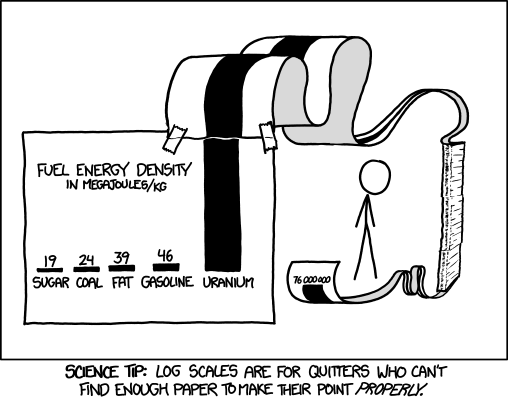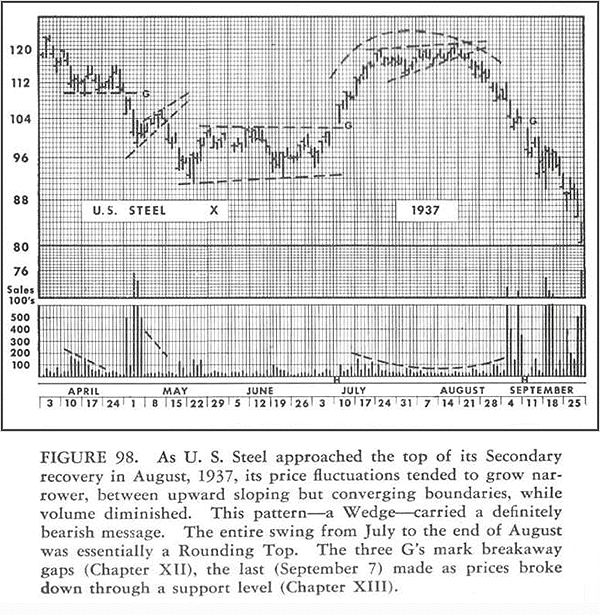In his broad account of monetary economics, Nick Rowe points out that most modern economies are closer to being pure monetary exchange economies than pure barter economies. I'll argue that we're about half way between the two poles, although it's impossible to say for sure.
A helpful way to determine whether an economy is barter or monetary is to look at all trades made over a period of time and count the frequency of occurrence of each good in trade. In a pure barter economy, no good will appear more than any other. We'll see a flat, or uniform, distribution of media used in trade. In a pure monetary economy, a single good should appear in all trades. The distribution will be uneven. Nick describes it a bit differently but it's the same idea:
You could make a table, with a list of all the different goods for the columns, and the same list of all the different goods for the rows. So it's a square table, with n columns and n rows, if there are n different goods. If you observe someone exchanging apples for bananas, you put a tick in row A column B. (Obviously you can ignore the main diagonal, because people don't exchange apples for apples, unless they are different varieties of apples, and you can ignore everything North-East of the main diagonal, because it's just a duplicate.)If there was such a thing as a universal dollar and all trade in an economy contained this item, then we'd certainly be living in a pure monetary economy. But in the real world, there is no such hypothetical item as "the" dollar. Dollars are heterogeneous. There are multiple types, brands, issuers, and denominations. To get to where we want, we often have to engage in a long chain of dollar-for-dollar barter transactions. Only when we've managed to acquire the right form of dollar can we buy the things we want. This means that no single type of dollar appears in 100% of an economy's trades. Using Nick's wording, we have ticks everywhere, not just in the A column/row.
In a pure barter economy, where any good can be exchanged against every other good, you would have ticks everywhere. With n different goods, there are n(n-1)/2 functioning markets.
In a pure monetary exchange economy, where apples (say) were the medium of exchange, there would be ticks everywhere in the A column or row, and no ticks anywhere else. With n different goods, there are n-1 markets, where in each market apples are exchanged for one of the other goods.
A monetary exchange economy has a lot fewer markets operating than a pure barter economy, for n > 2. Most economies are a lot closer to the pure monetary exchange economy than they are to the pure barter economy.
Types of dollars
In Canada we have the $1 dollar coin, or the loony, which is issued by the Royal Canadian Mint. If you try using loonies to pay for something worth over $100, say a washing machine, there's a good chance that you'll be turned away by the shopkeeper. To buy the washing machine, you'll first have to barter your loonies for larger-denomination paper dollars. Banks typically engage in this sort of barter. They'll either sell you paper dollars for your coins, or they'll sell you an electronic bank deposit. If you buy the paper dollars you can head back to the store and get the washing machine.
Canadian paper banknotes, created by the Bank of Canada (BoC), are accepted in a wider range of trade than loonies. But like the Mint's coins, BoC notes are not generally accepted. Say you need to get your clothes washed at the local laundromat. Since the washing machines are coin-operated, you'll have to sell notes and buy loonies in order to get them to work. Alternatively, say you want to buy the local laundromat, which the owner is selling for $2 million. The laundromat owner won't accept your offer of notes since having a few suitcases full of paper is awkward. Rather, you'll first have to barter away your notes for some medium more appropriate to the context. If you take your notes to a bank and purchase deposits, then you can transfer your deposits to the owner in return for the car wash. The owner will likely accept deposits, since holding $2 million at the bank will be safer for him than $2 million under his bed.
You could also offer to pay the owner with a personal IOU. If the laundromat owner accepts your IOU, he'll want to barter it away at some point. In the old days, he might have sold it on to another merchant in return for, say, a convenience store (see bills of exchange). Nowadays, the most popular form of IOU is probably the cheque. If the laundromat owner accepts your offer, he'll take your cheque to his bank and sell it for $2 million in deposits. His bank will in turn sell your $2 million IOU back to your bank in return for a $2 million deposit. Your bank will in turn sell your IOU back to you in return for a deposit.
You're in trouble if you don't have a sufficient deposit balance to buy back your IOU. It's for this reason that cheques are not generally accepted. If the writer of the cheque fails to settle their end of the bargain, the entire chain of dollar-for-dollar trades risks being unwound.
Nor are direct transfers of bank deposits generally accepted in trade. In order to purchase an exchange-traded stock or bond, for instance, you'll have to first sell your bank deposit for a deposit at a brokerage house. Now you can buy the stock. You're in trouble if you change your mind and decide that you want to buy a couch instead of a stock. Dollars in your brokerage account are useful only in financial market transactions, not retail transactions. You'll have to sell your brokerage deposit for a bank deposit, and only then will you be able to buy your couch.
I've left out another major type of dollar—deposits held at the Bank of Canada. A commercial bank that owns a deposit at another bank will often sell this deposit back to the issuer in return for a deposit held at the Bank of Canada. Deposits at the Bank of Canada can be used by banks to engage in all sorts of transactions with other banks.
But Bank of Canada deposits are not generally accepted. A bank, for instance, can't purchase a box of donuts from Tim Hortons with a central bank deposit—corporation or individuals aren't permitted to have accounts at the BoC and therefore can't accept BoC deposits as payment. To buy the box of donuts, the bank will have to sell some Bank of Canada deposits to Tim Hortons's bank, say the Royal Bank of Canada, in return for RBC deposits. It can then sell these deposits to Tim Horton's and get donuts.
In sum, the dollar is not some homogeneous entity. There are hundreds of thousands of implementations of the dollar. A list of all trades done in Canada over a period of time will show various types of dollars being exchanged for various goods & services and also being exchanged for each other. The distribution of appearance of each type of dollar in total trade is probably flattish, much as in theoretical barter. Liquid stocks and bonds and popular goods like coffee could very well appear in more trades than various types of dollars. The occurrence of cell phone minutes in trade, for instance, probably exceeds that of travelers' checks. The market value of transactions in which coins participate is probably exceeded by the market value of transactions in which S&P/TSX60 stocks participate. Our economy is less monetary and more barter-like than we commonly suppose.






